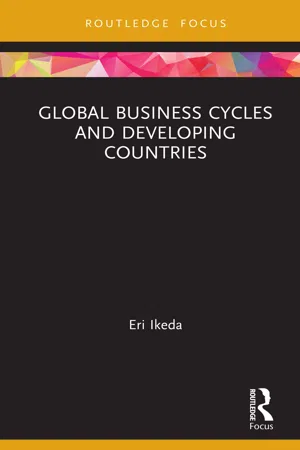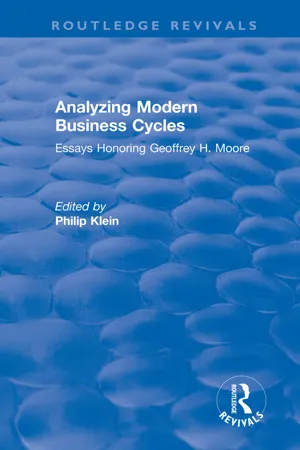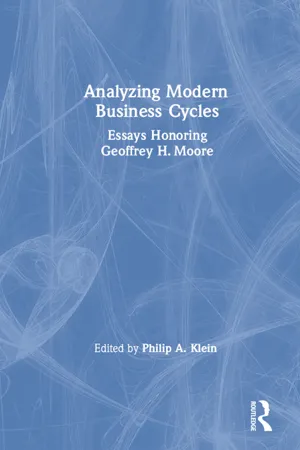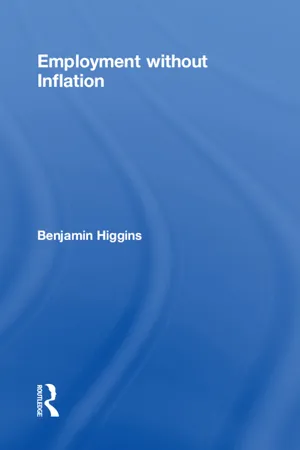Economics
Business Cycles in the United States
Business cycles in the United States refer to the recurring fluctuations in economic activity, including periods of expansion, peak, contraction, and trough. These cycles are characterized by changes in employment, production, and income levels. They are influenced by various factors such as consumer spending, business investment, government policies, and international trade. Understanding and managing these cycles is crucial for policymakers and businesses.
Written by Perlego with AI-assistance
Related key terms
7 Key excerpts on "Business Cycles in the United States"
- eBook - ePub
Economics for Investment Decision Makers
Micro, Macro, and International Economics
- Christopher D. Piros, Jerald E. Pinto(Authors)
- 2013(Publication Date)
- Wiley(Publisher)
Whereas the chapter on national income accounting and growth focused on long-term economic growth and the factors that help foster it, this chapter addresses short-term movements in economic activity. Some of the factors causing such short-term movements are the same as those causing economic growth, such as changes in population, technology, and capital. However, other factors, such as money and inflation, are more specific to short-term fluctuations.This chapter is organized as follows. Section 2 describes the business cycle and its phases, explaining the behaviors of businesses and households that typically characterize phases and transitions between phases. Section 3 provides an introduction to business cycle theory, in particular how different economic schools of thought interpret the business cycle and their recommendations with respect to it. Section 4 introduces basic concepts concerning unemployment and inflation, two important economic policy concerns that are sensitive to the business cycle. Section 5 discusses variables that fluctuate in predictable time relationships with the economy, focusing on variables whose movements have value in predicting the future course of the economy. A summary and practice problems conclude the chapter.2. OVERVIEW OF THE BUSINESS CYCLE
Burns and Mitchell (1946) define the business cycle as follows:Business cycles are a type of fluctuation found in the aggregate economic activity of nations that organize their work mainly in business enterprises: a cycle consists of expansions occurring at about the same time in many economic activities, followed by similarly general recessions, contractions, and revivals which merge into the expansion phase of the next cycle; this sequence of events is recurrent but not periodic; in duration, business cycles vary from more than one year to 10 or 12 years.This long definition is rich with important insights. First, business cycles are typical of economies that rely mainly on business enterprises—therefore, not agrarian societies or centrally planned economies. Second, a cycle has an expected sequence of phases representing alternation between expansion and contraction. Third, such phases occur at about the same time throughout the economy—that is, not just in agriculture or not just in tourism but in almost all sectors. Fourth, cycles are recurrent (i.e., they happen again and again over time) but not periodic (i.e., they do not all have the exact same intensity and duration). Finally, cycles typically last between one and 12 years. - eBook - ePub
- Eri Ikeda(Author)
- 2019(Publication Date)
- Routledge(Publisher)
vice versa . Perhaps one of the best described such conceptualisations of the business cycle is provided by Moore (1961, pp. 45–46):… the alternating periods of expanding and contracting economic activity defined as business cycles were characterized by a system of relations among different factors or aspects of economic activity… the system as a whole was extremely complex, both from a statistical and an economic point of view.For the majority of modern scholars, typically mainstream economists, business cycles are best described as random fluctuations in economic activities. This conception contains no implication of any periodicity. As a result, the term business ‘cycle’ is argued by some of these scholars to be a misnomer (see, for example, Prescott, 1986; Zarnowitz, 1992, p. 22; Knoop, 2010). The well-known mainstream economist Robert Lucas (1977, p. 10) is quite explicit in this regard, arguing that ‘attempts to document and account for regular cyclical movements need not be connected in any way to a presumption that such movements are an inevitable feature of capitalist economies’. Rather, cycles are seen as the result of shocks that hit the economy in a random manner resulting in its temporary deviation from an equilibrium, full-employment, growth path. Romer (n.d.) explains:Just as there is no regularity in the timing of business cycles, there is no reason why cycles have to occur at all…. Business cycles do occur, however, because disturbances to the economy of one sort or another push the economy above or below full employment.One of the tacit assumptions of the conception of cycles as random fluctuations is that the trend growth of the economy is independent of cyclical movement—there is no ‘path dependency’ of the trend on the short-run movement in economic growth.4 Specifically, it is assumed that the cyclical movement of the variable has no bearing on its long-term trend, and the expansion and contraction are defined as relative to the trend movement. Indeed, it is for this reason that the cycle is often referred to as a ‘deviation cycle’ (see the seminal work by Mintz, 1969, 1972).5 These deviation cycles are also known as ‘growth cycles’6 (see further elaboration in section on identification and existence of cycles below).7 - eBook - ePub
- Philip Kotler(Author)
- 2015(Publication Date)
- AMACOM(Publisher)
SEVEN BUSINESS CYCLES AND ECONOMIC INSTABILITYWatch the little things; a small leak will sink a great ship. —BENJAMIN FRANKLINBusinesses operate best when they have a clear picture of their target customers, their competitors, and the major demographic, economic, social, technological, and political forces affecting the broad business environment. Conversely, businesses operate poorly when many of those elements that deeply affect business performance are random and unpredictable.There are two great injectors of risk and uncertainty into business decision making. One is the persisting presence of business cycles in capitalist economies. The other is the rising level of market turbulence in this new era of globalization and rapid technological development. Let’s examine each in turn.THE PROBLEM OF THE BUSINESS CYCLEBusiness cycles seem to be an intrinsic feature in a capitalist market economy. From 1857 to today, the American economy has experienced thirty-three recessions. From 1960 until today, the United States experienced eight contractions (from peak to trough) of business activity.1 The average contraction period from peak to trough lasted thirteen weeks. The average period from trough to peak took sixty-five weeks. As you can see, the contraction period is short, but the return to the next peak is five times as long.The aim of economic policy is to keep the economy moving at a healthy growth rate. It should be able to create jobs for everyone who wants a job, and do so without causing inflation. This leads us to examine the following questions:- What are the phases of a business cycle?
- What factors generally precipitate a business contraction?
- What factors normally contribute to a more rapid recovery?
What Are the Phases of a Business Cycle? A business cycle passes through four phases.2Contraction - eBook - ePub
Analyzing Modern Business Cycles: Essays Honoring
Essays Honoring
- Philip A Klein(Author)
- 2017(Publication Date)
- Routledge(Publisher)
Classical cycles historically have been the main concern of business cycle studies at the National Bureau of Economic Research (NBER) in New York. The NBER studies began with the work of Mitchell (1927; see Moore and Zarnowitz 1986). The classical cycle fits the business cycle theories of Kalecki (1939) and Schumpeter (1939). It also fits the hints Keynes (1936) offered about the nature of business cycles; and it is the cycle that is clearly at the heart of the post-Keynesian models of, for instance, Kaldor (1940) and Hicks (1950). Table 3.1 shows that there was no classical contraction in the United States between February 1961 and December 1969, a period of 106 months; Table 3.2 shows a classical upswing continuing in Australia from September 1961 to July 1974, a period of 154 months. The experience of the 1960s, especially in the United States with no classical downturn between 1961 to 1969, contributed to a revival of interest in growth cycles. 4 Growth cycles are defined as fluctuations in the rate of growth of aggregate economic activity, with periods when the growth rate is above the long Table 3.1 Phases of Business Cycles, U.S., 1948-87 Table 3.2 Phases of Business Cycles, Australia, 1950-87 term trend rate alternating with periods when it is below this long-term value, but not necessarily negative. This enables account to be taken of the important fact that a slowdown may occur when the growth rate, though continuing positive, is slower than the long-term trend rate of growth. Hence excess capacity, notably unemployment, rises - eBook - ePub
Analysing Modern Business Cycles: Essays Honoring Geoffrey H.Moore
Essays Honoring Geoffrey H.Moore
- Philip A. Klein(Author)
- 2019(Publication Date)
- Routledge(Publisher)
Classical cycles historically have been the main concern of business cycle studies at the National Bureau of Economic Research (NBER) in New York. The NBER studies began with the work of Mitchell (1927; see Moore and Zarnowitz 1986). The classical cycle fits the business cycle theories of Kalecki (1939) and Schumpeter (1939). It also fits the hints Keynes (1936) offered about the nature of business cycles; and it is the cycle that is clearly at the heart of the post-Keynesian models of, for instance, Kaldor (1940) and Hicks (1950). Table 3.1 shows that there was no classical contraction in the United States between February 1961 and December 1969, a period of 106 months; Table 3.2 shows a classical upswing continuing in Australia from September 1961 to July 1974, a period of 154 months. The experience of the 1960s, especially in the United States with no classical downturn between 1961 to 1969, contributed to a revival of interest in growth cycles. 4 Growth cycles are defined as fluctuations in the rate of growth of aggregate economic activity, with periods when the growth rate is above the long-term trend rate alternating with periods when it is below this long-term value, but not necessarily negative. This enables account to be taken of the important fact that a slowdown may occur when the growth rate, though continuing positive, is slower than the long-term trend rate of growth. Hence excess capacity, notably unemployment, rises. On the other hand, during the expansion phase of the growth cycle, when excess capacity is being absorbed, the actual rate of growth is above the long-term trend rate of growth. Table 3.1 Phases of Business Cycles, U.S., 1948–87 Sources: a CIBCR 1988a. b U.S. Department of Commerce 1988, p - Bernard S. Katz, Ronald E. Robbins(Authors)
- 2017(Publication Date)
- Routledge(Publisher)
Nearly a third of Professor Mitchell’s treatise is devoted to an analytical explanation of the uniformities among business cycles. During each business cycle there are decided but uneven fluctuations in the prices of particular commodities and kinds of labor, marked variations in the physical volume of trade, in rates for loans, in the yield of securities, and in the efficiency of labor. As a consequence of all of these variations there are wide fluctuations in money costs of production and in business profits. All these variations, it is argued, are an inevitable consequence of the existing organization of economic activities upon a pecuniary basis, in which the principal directing influence is exercised by business men in the quest of profits. During a period of prosperity, for example, industry becomes subject to numerous stresses and strains of increasing intensity owing to the business undertakings which are occasioned by, and which in turn occasion, the various fluctuations mentioned above. Finally, a reaction becomes inevitable, and during the subsequent period of depression changes in the opposite direction pave the way for another period of activity for the beginning of a new cycle.It is not possible, within the limits of a review, to give any adequate idea of the clearness and convincingness of this brilliant example of economic analysis. But precisely because the analysis is so convincing and well documented, there is a danger that the reader may draw the conclusion that a complete analysis of the business cycle has been accomplished. To the reviewer, at any rate, it would seem clear that only a part of the complex phenomena of the business cycle has been explained. The uniformities among business cycles arising out of the organization of industry upon a pecuniary basis have to do with factors which by themselves would occasion merely slight temporary oscillations in the condition of trade. A short period of depression is sufficient to correct maladjustments directly due to such factors as tension in the money markets, the uneven movement of prices, and the inefficiency of labor which develops during a period of superabundant employment. The difference in duration and intensity of the depression following the crisis of 1873, compared with that accompanying the reaction in 1903, is not explained by differences in price movements or other distinctly pecuniary matters. It is noteworthy in this connection that Professor Mitchell distinguishes four complete cycles in the United States between 1890 and 1910, a period during which, if pronounced changes only are taken into account, there were not quite two complete cycles.- eBook - ePub
- Benjamin Higgins(Author)
- 2018(Publication Date)
- Routledge(Publisher)
“the business cycle.” Probably the cycle that has caused most concern and received most attention is the one of about ten years—give or take a few years in either direction—and identified with Clément Juglar. Some economists, including Hansen, Kuznets, and Schumpeter have identified a construction cycle of about twenty years. Finally, there is the “long wave,” or Kondratieff cycle of about fifty years. As may be expected, the degree of regularity claimed for each of these cycles varies somewhat.The second point is that no one ever claimed complete regularity for any of these cycles. The economy is too much affected by random shocks for that. What is maintained is that the capitalist economic system contains mechanisms which incline it to fluctuations of varying durations in a more or less regular pattern. Tugan-Baranowsky, for example, in his pioneering work of 1894, spoke of (Juglar) downturns at intervals of seven to eleven years. Hansen, summarizing Tugan Baranowsky, says: “The cycle is not a phenomenon regulated by mathematical laws. The movement is periodic in the sense that there occur successive phases of prosperity and depression which rise and fall like a cycle. The industrial cycle may be conceived of as a law inherent in the very core of the capitalist economy.” Hansen also makes the point that the great contribution of Juglar, writing in 1860, was that he “was one of the first to see that the problem is not one of crises but of cycles” (Hansen, 1951, 280–82). But do these cycles have enough regularity to justify the intensity of the search for a theory that would explain them? Burns and Mitchell, for example, maintain that if we are speaking of observed behavior of economic systems, and not about theoretical models, Schumpeter for one claimed too much regularity for his cycles (Burns and Mitchell, 1946, 440–42). But the National Bureau has frequently been criticized for its reluctance to develop theoretical models of its own, insisting on the need for more and more facts before such models can be built, and its implication that people who build models until all the facts are collected are wasting their time (Koopmans, 1947; Burns and Mitchell, 1946). The reader can make up his or her own mind on this question, perhaps after consulting more of the literature and looking at more of the facts. My own view, however, is that there is too much repetitiveness, too much regularity, in the nineteenth- and early twentieth-century experience to attribute it entirely to a series of random and unrelated shocks, and the search for a systematic theory that would provide explanations in terms of the intrinsic nature of industrial and financial system itself was fully justified.
Learn about this page
Index pages curate the most relevant extracts from our library of academic textbooks. They’ve been created using an in-house natural language model (NLM), each adding context and meaning to key research topics.






